Briefly discussed in this post: 13 books (Helgoland; Black Sun; A Brief History of Neoliberalism; On Necrocapitalism; The Old is Dying and the New Cannot Be Born; The Precariat; On The Take; Dismantling a Nation; The Normal and the Pathological; Enchanted Hunters; Lost Time; Case Study; and Inward); 5 movies (Possessor; Infinity Pool; Knock at the Cabin; Emily the Criminal; and Bones and All); and 7 documentaries (Pamela; The Cleaners; The Order of Myths; The Troubles We’ve Seen; MH370; Love in the Time of Fentanyl; and I Got a Monster).
BOOKS
1. Rovelli, Carlo. Helgoland: Making Sense of the Quantum Revolution (2021 [2020]).
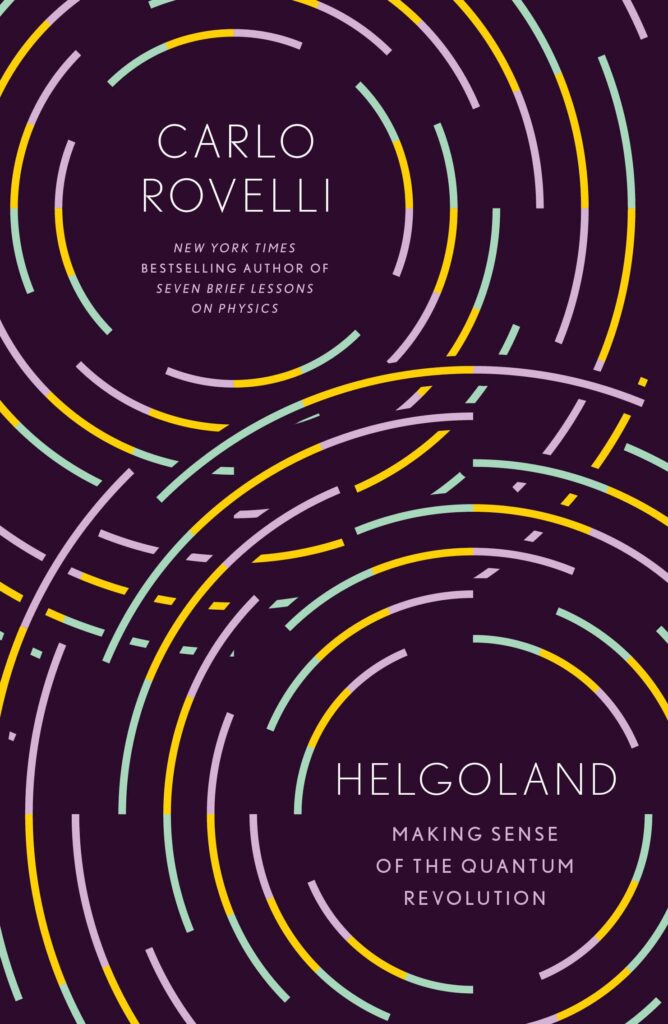
According to Carlo Rovelli, the fundamental lesson we have learned from quantum physics over the last one hundred years, is that the universe is not composed of things but of relations. What we used to think of things with particular inherent features, attributes, or essences, are really actually nodal points in ongoing, interconnected (Karen Barad would say diffractive) processes and events that extent backwards, forwards, sideways, and everywhere in time-space. Thus, any features that any thing has, it only has at the moment when in an observable relation to something else. Reality, in other words, is much less substantial and much more inter- and intra-relational. Rovelli does a great job of breaking all of this down in a way that is comprehensible and even compelling to non-physicists. He even waxes poetic at times. I enjoyed the book. One of the things that I find amusing and exciting about advances in contemporary science (from quantum mechanics to botany to ecological developmental evolutionary theory) is the ways in which the most exciting, cutting-edge, mind-blowing results are, increasingly, just confirming what Indigenous people have taught and believe for tens of thousands of years. Ain’t that something?
2. Kristeva, Julia. Black Sun: Depression and Melancholia (1989 [1987]).
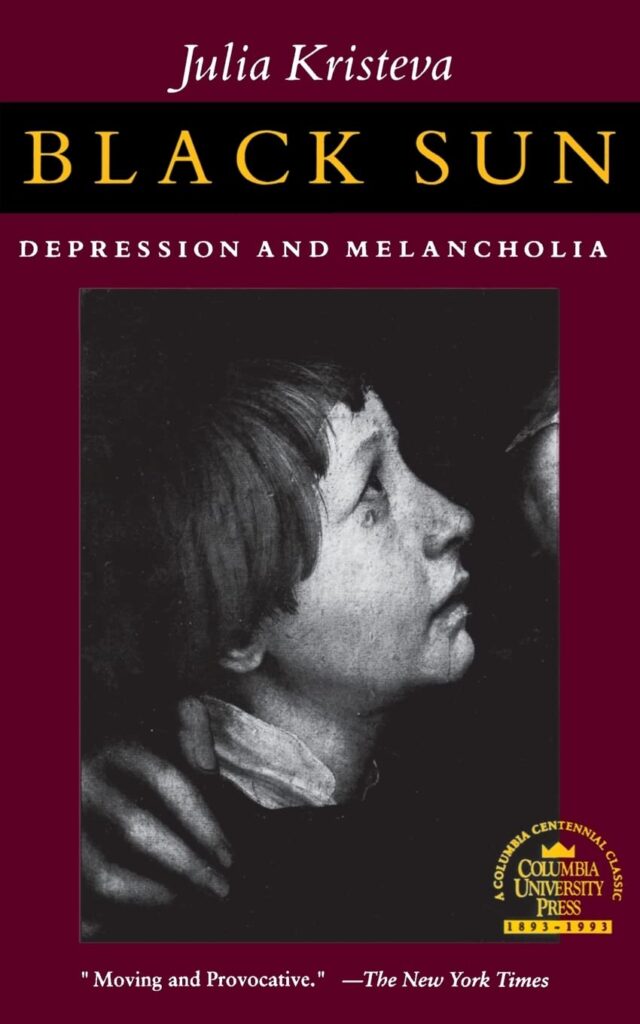
When the self is fragile, and when narcissistic elements are strong in love (wherein the beloved becomes the idealized other [the Ego Ideal] who reflects back to the lover their idealized image of themselves [the Ideal Ego]), the loss of love, Kristeva suggest, can lead to the total fracturing and dissolution of the self. In such cases, sadness can become a substitute attachment-object around which the self can hold itself together. “Sadness,” Kristeva says, “reconstitutes an affective cohesion of the self, which restores its unity within the framework of the affect.” Thus, “[t]he narcissistic mood constitutes itself as a narcissistic support, negative to be sure,” but one which prevents the subject from “proceeding to the suicidal act.” Thus, somewhat tragically and paradoxically, “the sadness that overwhelms us… [is] also a shield—sometimes the last one—against madness.” In relation to lost love, Kristeva explains things in this way:
“My sadness affect is the ultimate yet mute witness of my having, in spite of all, lost the archaic Thing [the Ego Ideal] of omnipotent ascendancy. That sadness is the final filter of aggressiveness, the narcissistic restraining of a hatred that is unacknowledged not because of simple moral or superego decency, but because in sadness the self is yet joined with the other, it carries it within, it introjects its own omnipotent projection—and joys in it. Sadness would thus be the negative of omnipotence, the first and primary indicator that the other is getting away from me, but that the self, nevertheless, does not put up with being abandoned.”
Thus, Kristeva argues that the work of psychoanalysis is not to help people flee from their sadness, but to help them to sit with it, permit it to blossom, and work through it from the perspective that, perhaps, “the wealth of my sadness” is “my way of protecting myself against death” (of the other and/or of myself). In doing this work, the psychoanalyst asks the depressive what other means they might have to work out their suffering.
As someone who has often endured long periods of sadness, I found Kristeva’s reflections to be compelling. It explains the persistence and seductiveness of sadness that is well-known to melancholics. Her question about how else a person who suffers from depression might choose to work through their suffering also caught me sideways. I’ve been thinking about this a lot.
Unfortunately, all of the really good thought-provoking stuff came in the first half of the book and the second half, starting from her description of Holbein’s painting of Dead Jesus got really dull, really fast. The first one hundred pages are pretty stellar, tho.
3. Harvey, David. A Brief History of Neoliberalism (2005).
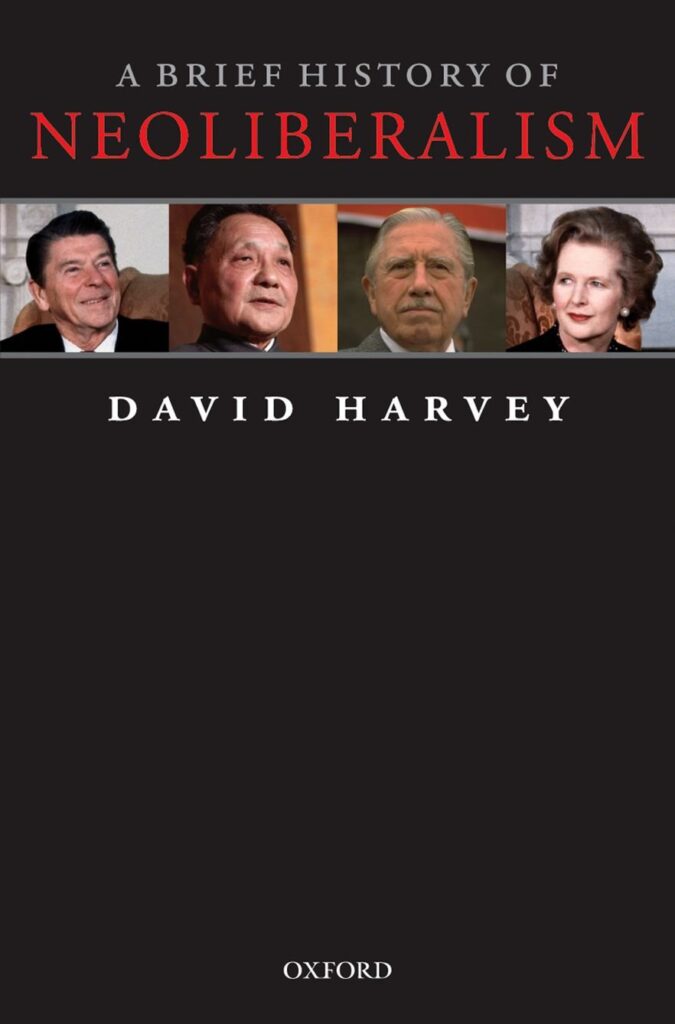
Undoubtedly one of the books to read on the topic of neoliberalism, Harvey does an exceptional job of drawing together the various dynamics of neoliberal theory, praxis, and contextualization, to map out how the world got to where it was by 2005 (and, in fact, Harvey foresees the economic crisis of 2008 and also foresees that, even in the midst of such crises, the greediest hoarders of wealth, who have the biggest hoards, will not relinquish what they have stolen from someone else and will, instead, either steal more or let the whole world burn—something I missed when I first read this book 20+ years ago!). As, perhaps, the leading living Marxist scholar, Harvey’s keen insights, awareness of class power, and breadth of historical and economic knowledge is a gift to us all. If you’re looking for somewhere to start on this topic, I suggest you start here.
4. Asma, M. I. On Necrocapitalism: A Plague Journal (2021).
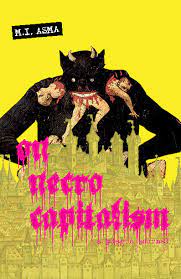
I distrust academics who write polemical tracts filled with neologisms decrying other theorists whose intercessions are ever only linguistic or theoretical. I distrust those who call for action who offer no evidence of action, but who really do know how to turn a phrase. I also distrust academics who want to make of everyone an enemy if we disagree on this or that point of significance. People on all sides are making critical errors. People on all sides have been violent—and not in a good way. Where, then, do we go seeking co-conspirators, friends, or even allies? Who do we coax? Who do we cajole? Who do throw down and punch-out in the streets? And who do we treat tenderly? Who, even, of those we might find deeply problematical, oppressive, and hurtful at times, do we not treat as a mortal enemy? Or are we fighting everyone to the death? Bah. Stalinists (because, although this collective quotes Lenin a fair bit and doesn’t ever mention Stalin, I can’t help but think the word “tankie” while reading them). Unrelenting war on all fronts is tiresome (and a terrible strategy) and, despite noble sentiments about working towards full communism and the emancipation of the oppressed who are most brutally abandoned, exploited, or abused under necrocapitalismTM, I can’t help but wonder whose itches are being scratched with these essays.
Those on the frontlines of the class war those who hoard wealth are waging against those whom they impoverish talk about the dangers of “trauma vomiting” when they get together after work. Nobody can relax. Everyone is appalled. The horror, the horror. So, when they get together for drinks or tokes or bumps of coke, they end up vomiting traumatic story after traumatic story onto their peers—who are more than happy to reciprocate—and this ever-more-traumatizing doom spiral ends up being a perhaps not super useful but nonetheless cathartic release. I wonder of the same is true, mutatis mutandis, with the edgelords of radical theory and the production of polemics. Fuck those people. And fuck those people. And fuck everyone. They’re so wrong. Yeah! That’s what I was going to say, too, because, yeah, fuck those fucking fucks!
5. Fraser, Nancy. The Old is Dying and the New Cannot Be Born: From Progressive Neoliberalism to Trump and Beyond (2019).

A small tract with one middling-sized article and one short interview, this book lays out Nancy Fraser’s reflections on the hegemonic rise and fall of progressive neoliberalism (which “combined an expropriative, plutocratic economic program with a liberal-meritocratic politics of recognition”). This largely occurred, in the English-speaking world, after the initial surge of neoliberal changes created by “regressive neoliberals” (Reagan, Thatcher, Mulroney) through neoliberalism into crisis. Political opportunists like Clinton, Blair, and Chrétien, actually extended the reach and influence of neoliberalism by wedding it to the mainstream Left political bloc. In this way, Fraser observes, “[t]he progressive-neoliberal program for a just social order did not aim to abolish social hierarchy but to “diversity” it, “empowering” “talented” women, people of color, and sexual minorities to rise to the top.” However, as more and more people felt boxed out of the gains promised by this hegemonic ideology and Liberal and Conservative parties that supported it, the hegemony of the neoliberal paradigm was (and continues to be) increasingly shaken. A push for both “regressive populism” (Donald Trump, Boris Johnson) and “progressive populism” (Bernie Sanders, Jeremy Corbyn), gave way to what ended up being “hyper-reactionary neoliberalism,” which has only extended and deepened the interregnum in which we find ourselves wherein various morbidities flourish as, to quote Gramsci, “the old is dying and the new cannot be born.” What comes next? It’s hard to say. The interregnum can potentially exist in perpetuity. Or maybe we end up with something even more like fascism than what we have already. Or maybe everything gets blown the fuck up. Or maybe a new, more democratic hegemonic bloc can slowly form and alter the conditions of what is possible or imaginable in the future.
6. Standing, Guy. The Precariat: The New Dangerous Class. Special COVID-19 Edition (2021 [2011]).

More and more people, in more and more diverse circumstances, have more and more shitty jobs. And more and more shitty lives. At least when it comes to struggling to survive relentless demanding present and an uncertain and anxiety-provoking future. Standing looks at the various dynamics of precariousness that have been structured into the lives of the working classes that give rise to this. He names those afflicted by these greed-induced socioeconomic and political dynamics, the precariat. Given their great diversity, Standing argues that the precariat is a “class-in-the-making” and not yet a “class-in-itself” or a “class-for-itself.” The question that concerns Standing is what kind of class allegiances, dynamics, and ideologies will the precariat embrace as its class formation occurs. Will they embrace the neo-fascism that is being promoted by Christians and White people more generally across the Occident, or will they engage in a more revolutionary analysis, build allegiances across gendered and racialized boundaries that are encouraged by the wealthy to keep them apart, and engage in a more liberatory politics? Undoubtedly they will, and have, been doing both and other things besides (as Standing also observes, hopelessness and malaise about trying to change the dynamics of society are strongly encouraged in the precariat and, in fact, their lives are structured in such a way as to make despair almost inevitable). I found Standing’s analysis to be… decent. At times you can sense he is amongst the more privileged ranks of those who are being propelled towards some version of precarity (i.e. academics). Sometimes, it feels like he might be a little less afraid of impoverished people if he spent more time among them.
7. Cameron, Stevie. On the Take: Crime, Corruption and Greed in the Mulroney Years (1995).

It’s hard not to think of the wave of blockbuster mafia films that came out of Hollywood from the ‘70s through the ‘90s (from The Godfather [1972], to Scarface [1983], Goodfellas [1990] and Casino [1995]), when reading about Brian Mulroney’s federal government that was nine years in power (1984-1993). Like Reagan and Thatcher in their respective states, Mulroney oversaw the Canadian transition from Keynesianism to neoliberalism. Neoliberalism is more about a goal (the consolidation of wealth and power in the hands of those who are already rich), with some particularly effective strategies (privatization, deregulation, increased expansion and enforcement of private property related laws, etc.), and because of this it always is somewhat ad hoc and diverse in how it comes into being in various contexts. How neoliberalism came to the USA (with the support of the Moral Majority) is different than how neoliberalism came to the UK (giving social housing tenants the opportunity to buy their homes and transition to private ownership) and is different than how it came to Chile (through a military coup and years of terror and torture). So, too, Canada has its own unique path into this economy of devastation (Canada learned from both the US and the UK but didn’t perfectly mirror either) and so I’ve been trying to learn more about that. Unfortunately, its hard for some journalistic writers, like Stevie Cameron in this case, to go beyond the salacious details of the corruption, cronyism, toll-gating, grifting, kickbacking gangsterism of the whole roster of politicians, staff members and supports of Mulroney’s government. Which I understand. That sells popular books to the large numbers of people who read popular books. And that is largely what this book is about (and, to be fair, it never pretends to be otherwise—it’s all right there in the title after all!). But I skimmed through it to learn what I could about economic changes, and alterations in democratic structures that took place during the Mulroney years for which we, everyday working people, continue to pay the price today.
8. McBride, Stephen and John Shields. Dismantling a Nation: Canada and the New World Order (1993).
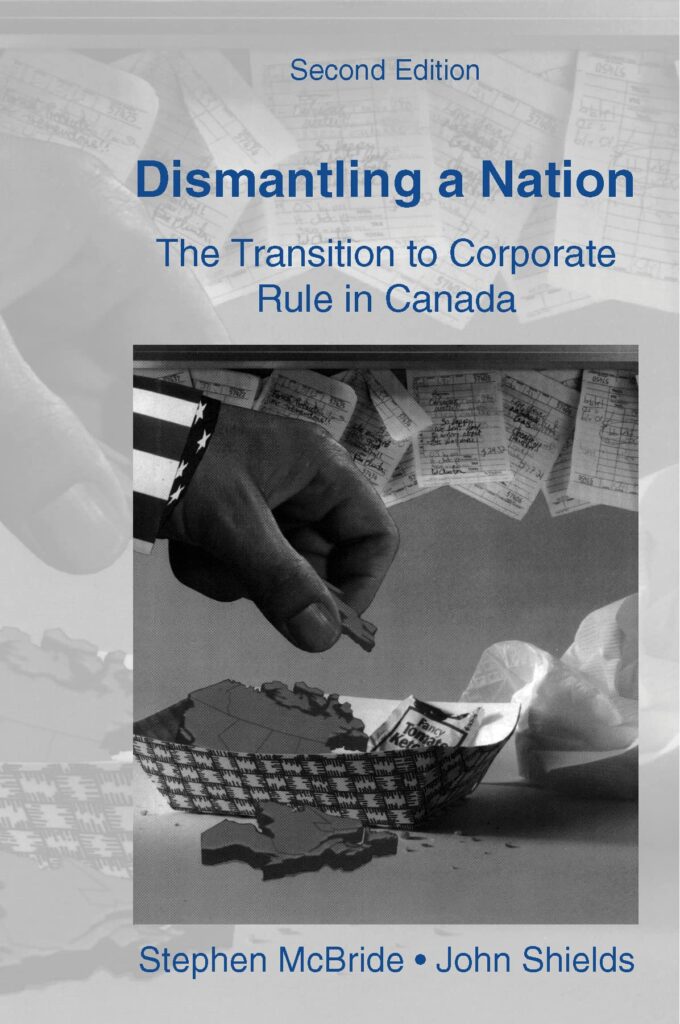
The Mulroney government (1984-1993) paved the way for the Canadian embrace of neoliberalism, austerity, privatization, the increasing criminalization and policing of the forcibly impoverished, and the consolidation of political power in the wealthy class. McBride and Shields look at some of the ways in which this played at as neoliberalization always plays out in strategic, at hoc, contested, and contextual ways. As a Canadian, it’s useful to understand the particularly Canadian dynamics of this class war. Pretty dry reading, for those who don’t get excited about economics, but important for understanding how we got here, where here is, and how we might get somewhere else.
9. Canguilhem, Georges. The Normal and the Pathological (1989 [1966]).

Canguilhem, in a text that heavily influenced Foucault (and therefore all of us!), demonstrates how notions of health and sickness are always entwined with broader socio-cultural value judgements related to good or bad, righteous or sinful, normal or abnormal, useful or useless. It’s a book that obviously influenced not only French theory (think Foucault’s Abnormal lecture series or his The Birth of the Clinic) but others who have analyzed how the discourse of health replaces religion as the ideology that justifies the State’s use of force (think Deviance and Medicalization by Conrad and Schneider). I enjoyed reading the book although anyone familiar with Foucault’s oeuvre probably won’t find anything particularly novel here.
10. Tatar, Maria. Enchanted Hunters: the power of stories in childhood (2009).
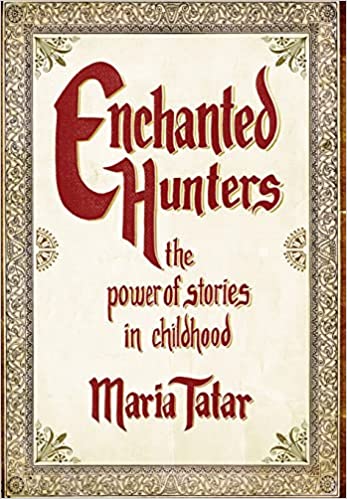
Life is full of boredom, beauty, horror, and enchantment (which we now call “trauma,” if it comes in the form of an evil spell, and sometimes still refer to as “a miracle,” when it is good). Any story, if it is to be lifelike and, if not truthful at least honest, must contain all of these elements. And this, I think, is partly why I have always been drawn to folk and fairy tales. Life is not all Dick and Jane and Spot (as children were taught at a time when they were forced to conclude that books are boring as fuck). It’s more like waiting to get dicked by Jane in my love spot. Maria Tatar explores these dynamics in Enchanted Hunters (which, as a title alludes to more than meets the eye—the well-versed reader is aware that, for all its beatific innocence, the title is also the name of a hotel in Lolita where the titular character is first raped by Humbert Humbert). I first discovered Tatar via her study of the representation of rape-murders (Lustmord) in Weimar Germany. So, I thought, she seemed uniquely well-equipped to explore the vicissitudes, complexities and seeming anomalous disjunctions of children’s stories. All in all, I enjoyed the book, not least because it reminded me of the importance of boredom and of being bored (in a way that complimented Adam Phillips’ engaging exploration of that subject), and because it led me back, once again, to a restored sense of curiosity and wonder that moves imperceptible from text to life and back again. Fun stuff.
11. Czapski, Józef. Lost Time: Lectures on Proust in a Soviet Prison Camp (2018 [1987]).

I’m not always an elitist snob when it comes to literature, but when I am, I usually read something related to Proust. I don’t read the hagiographies, secondary literature, mass produced academic essays that accumulate around some writers but Proust, well, I admit to indulging a little here. So, hearing about a group of Polish officers held in a Soviet prison camp during the Second World War discussing In Search of Lost Time and the life and death of Marcel, well, that sounded like a fun conversation to listen in on. And, yes, it was fun. Brief but fun. It’s impressive how people in different cultures can commit so much to memory (as demonstrated by Czapski’s impressive recollection of Proust’s material) whereas those of us living in highly digitized cultures have had our brains rewired to memorize, not information per se, but how to access information if we need it.
12. Macrae Burnet, Graeme. Case Study (2022).
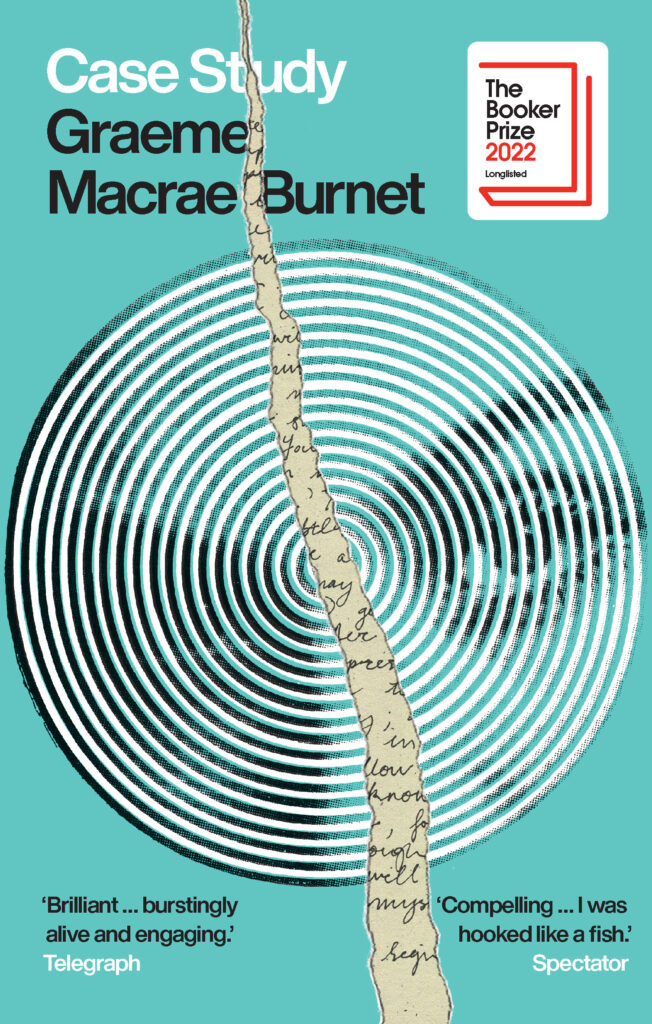
Case Study is a fun story that blurs fact and fiction as it recounts the history of Scotland’s little-remembered psychiatric (but anti-psychiatry) enfant terrible, Colin Braithwaite. The story moves us through material gathered by the author and a series of journals written by a fictitious patient of Braithwaite. It’s clever, humourous, and thought-provoking. The characters are well-developed and increasingly fun to engage with as you, the reader, increasingly realize, hang-on, everything might not be quite as it is being presented here. I enjoyed the story and hope to read more contemporary Scottish literature soon.
13. Lacera, Diego Perez (yung pueblo). Inward (2018).
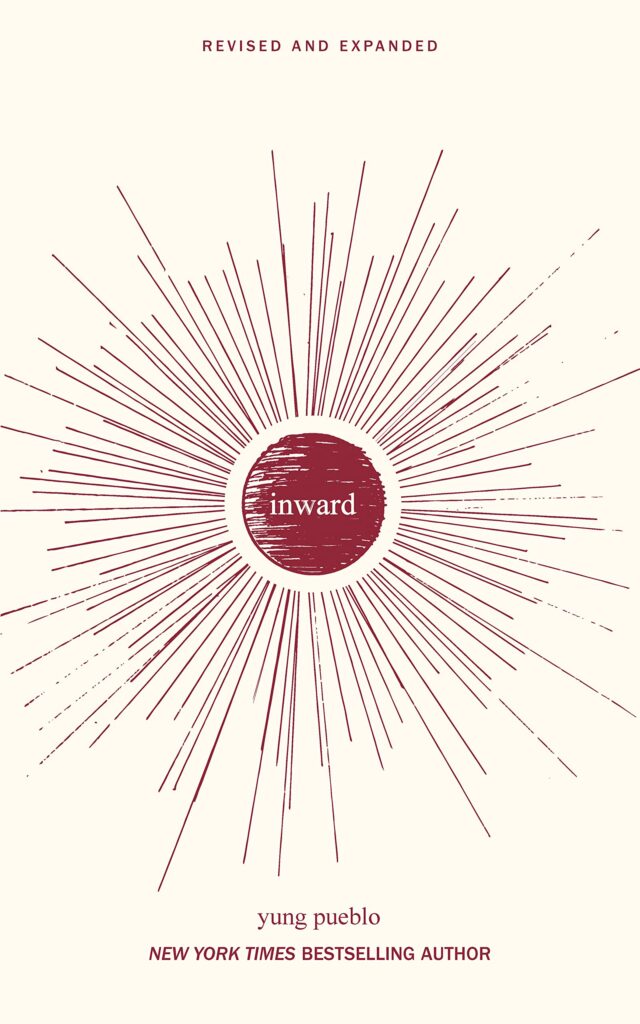
If you’ve ever wondered where the inspirational quotes found on posters of sunsets and White women doing yoga on the walls of various social services, well, good news—I’ve found the source! It’s the poetry of yung pueblo! I tried to read these poems mindfully. And, after I finished the poems and dropped the book in a Little Free Library around the corner, I whispered, namaste, and loved myself so much it healed the world. Thanks, yung pueblo!
MOVIES
1. Cronenberg, Brandon. Possessor: Uncut (2020).
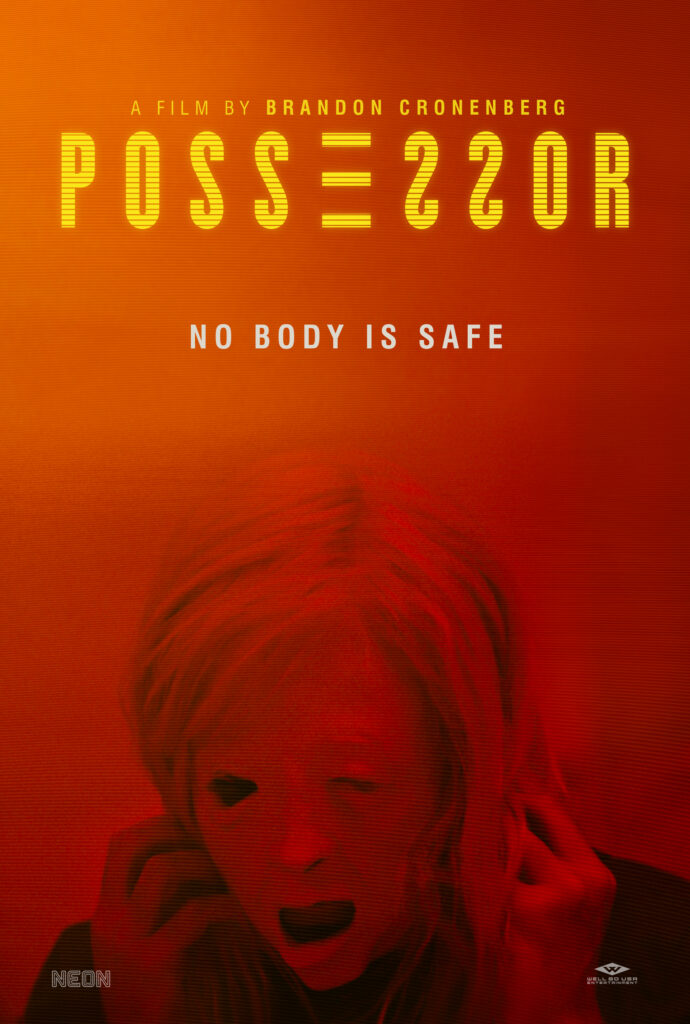
Bukowski is famous to advising people to “find what you love and let it kill you” but he was an asshole and tended to neglect mentioning how many other people you harm or kill as you go about doing this with yourself (or, if he did mention harm—and he actually did mention it quite often—it was more in the form of war stories, “you won’t believe this crazy young bitch who kept wanting to fuck me even though I just wanted to barf in my sink and write poetry…”, and no so much in the form of recognizing others as human beings for whom I might share some kind of responsibility). I was thinking about that quote again, after watching Possessor, because the protagonist, Tasya Vos (played very well by Andrea Riseborough, who is clearly building a larger fan base with every film she does), loves her job and, well, there’s a fair bit of killing involved. So, it goes in the near-future capitalism which is equal parts sci-fi, surveillance (but, like, total and inobtrusive surveillance… except for when it becomes very, very intrusive), wealth, work, and unfiltered horror (content warning because, damn, yep, there is some bloody violence here and the camera never blinks). It’s a well-told tale and, with just one movie, Brandon Cronenberg has impressed me more than his father, David, ever did.
2. Cronenberg, Brandon. Infinity Pool (2023).
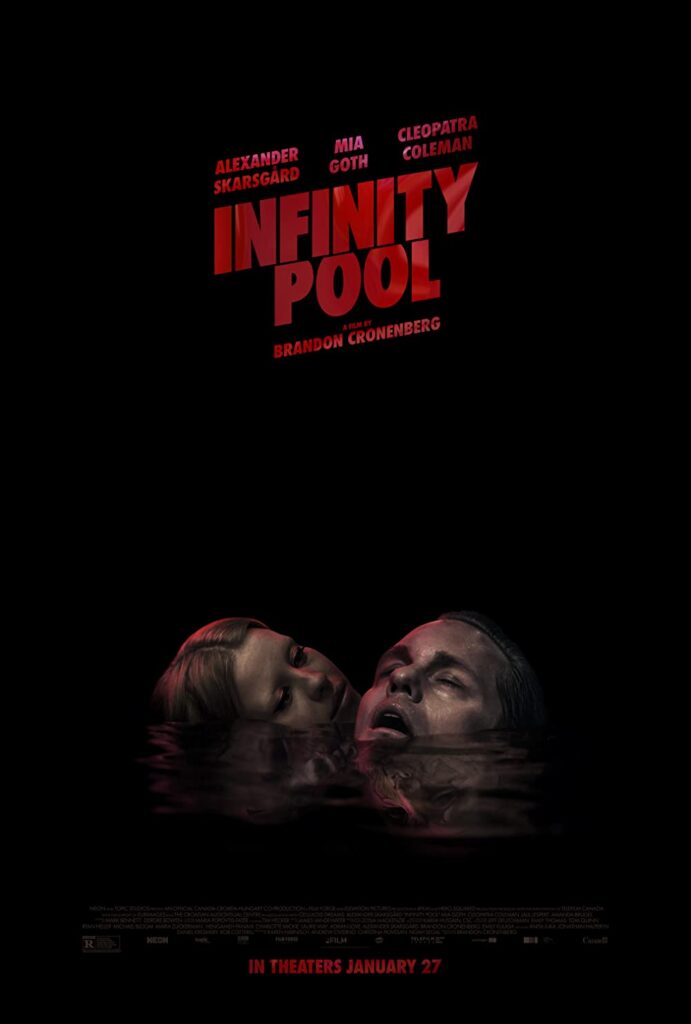
I once read (or watched?) a solid analysis of the first six Star Wars movies that argued the key to the success of the Star Wars franchise was not the genius of George Lucas but was actually the way in which the film studio was able to reign him in and force him into making good movies (Stars Wars and The Empire Strikes Back) instead of giving him free reign to indulge himself. Because once everyone became convinced that George Lucas was a genius (including George Lucas himself), they stopped reigning him in and his movies became remarkably shitty, remarkably fast.
I was thinking about this after watching Brandon Cronenberg’s second film, Infinity Pool. After the well-deserved accolades he received for Possessor and, perhaps, with a little help from his daddy’s fame and name, he was clearly given a bigger budget, an all-star cast (Alexander Skarsgård and Mia Goth being front and centre), and a lot more leeway for this movie. And it was two hours long and it totally sucked and even when it was supposed to be amping up, I was just looking forward to it being over. And, thank god, it’s over and I got through it so you don’t have to. Unless you want to. More power to ya.
3. Shyamalan, M. Night. Knock at the Cabin (2023).
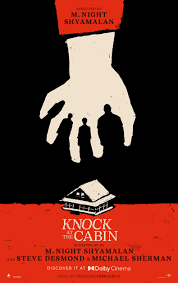
The best “cabin in the woods” movie since The Cabin in the Woods (2011), and the best Shyamalan movie since The Sixth Sense (1999), I had a lot of fun with this one. It’s creative and clever in a very understated way—which is a really refreshing change from the series of oh-my-god-look-I-am-trying-so-so-hard-to-be-clever films that have haunted Shyamalan since his debut. Part of what’s fun about the film is thinking through what it would be like to be in the shoes of the different characters, part of what’s fun about it is just how fully the actors do put themselves in the shoes of their different characters, and part of what’s fun is thinking about how things might have gone different if some characters were different or if different people made different decisions. Like many a well-told tale, it doesn’t just tell its own story well, it makes you want to tell all kinds of other stories, too. Recommended viewing!
4. Ford, John Patton. Emily the Criminal (2022).
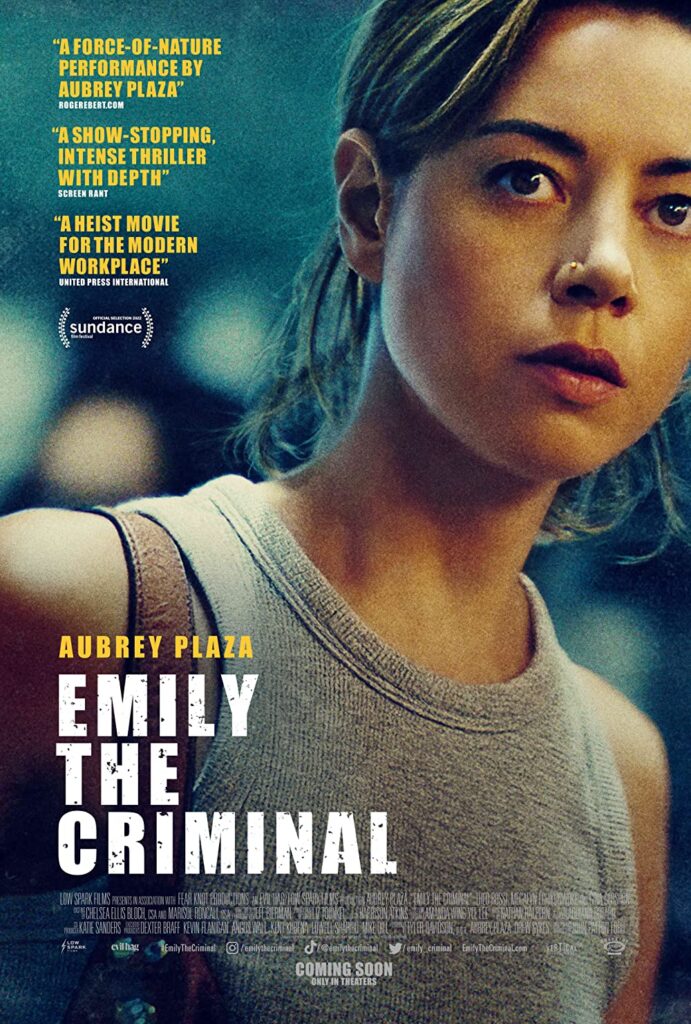
The law, when it is in its proper place, exists to serve people. If the law is elevated to an improper place, people are made to serve the law. Everything goes wrong when that happens. Thus, for example, people are always quick to point out that everything the Nazis did was legal in Germany but, more to the point, we need to remember that neoliberalism is, in many ways, a system of global devastation premised upon the supreme rule of law. Thus, we should never confuse legality with morality. What is legal often has little or nothing to do with what is right or moral.
I was thinking about these things when watching Emily the Criminal, which is the story of a woman who absolutely cannot escape crushing poverty, menial work, and precarious life in Los Angeles. Thus, she chooses to supplement her income via some illegal activities. But here’s the kicker—even if you try to be a good person (which does not preclude you from being a criminal, especially since neoliberalism has created all kinds of new forms of “private property” and property-related crimes that didn’t exist anywhere half a century ago!), the crushing ubiquity of the death-dealing nature of global capitalism, may mean that we end up being compelled into making selfish decisions that hurt others. I couldn’t help but think of Sayak Valencia’s work on Gore Capitalism or Achilles Mbembe’s thesis on Necropolitics. Neoliberalism is massively death-dealing but what makes it insidiously cruel is the way in which it forces all of us, at one time or another, to be cruel in order to live.
5. Guadagnino, Luca. Bones and All (2022).

Luca Guadagnino became a household name when Call Me By Your Name dropped in 2017. His follow-up, a remake of Dario Argento’s 1977 piece, Suspiria (a cult classic is is often treated as the definitive giallo film by the quintessential giallo director), didn’t live up to they hype (both as a remake and as Guadagnino’s post-Call Me By Your Name film). However, with Bones and All, he almost perfectly balances love and horror, magnificence and minuteness, affect and narrative. And Mark Rylance’s performance of Sully is, perhaps, the most genuinely, existentially creepy character I’ve seen on film in quite a long time—creepy, not because he’s so “out there” but because he so adroitly embodies all of what is so deeply creepy about most regular, everyday, men. Easily the best cannibal-type film since Julia Ducournau’s still unparalleled Raw (2017). Recommended viewing.
DOCUMENTARIES
1. White, Ryan. Pamela: A Love Story (2023).
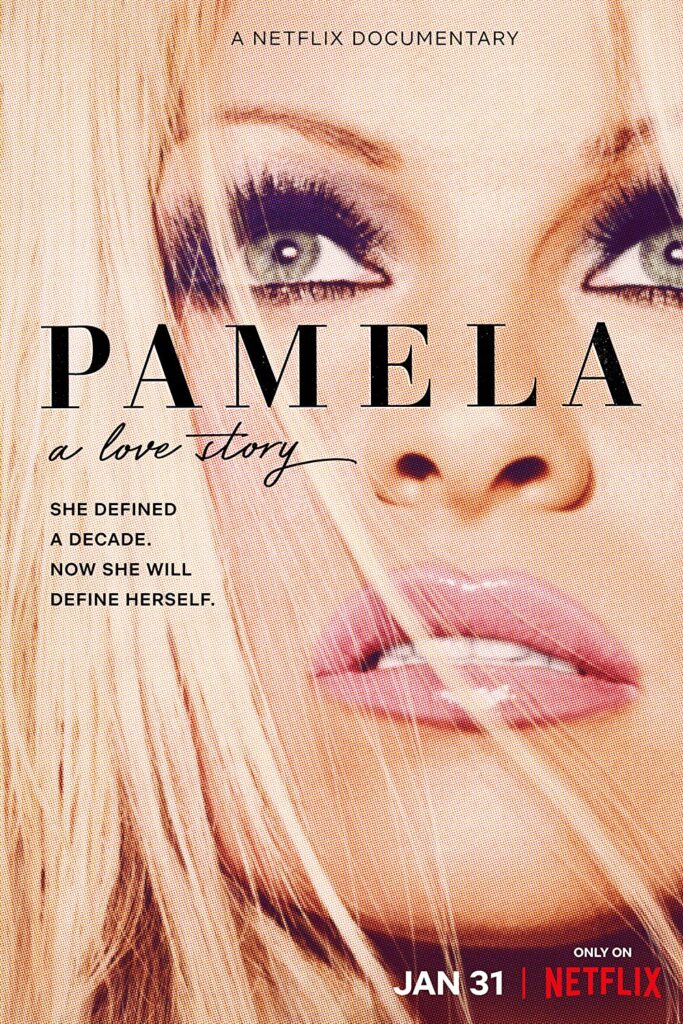
Dear Pamela,
I watched your documentary and wondered:
How many men must a woman survive in our culture
Before she can be free?
And I thought maybe that’s a trick question
Maybe there is no limit to the selfishness and violence and number of men
And maybe there’s no such thing as a free woman in our culture
But I thought again of you
How marvelous!
Because somehow you are free
And Pamela,
I think the world we have created is especially cruel
To women who love to be in love
And how revel in romance
But Pamela,
I’m so very glad you do
And also glad that now
You’re romancing you
Dear Pamela,
I’m not a pretty girl
Or a phoenix who rose from the ash
I’m just the aftermath
Of a boyhood fraught with violence and fear
But Pamela,
Like you, I survived a good many people and places
Adventured my way through beauty and horror
Became intimate with love and loss and loving again
Until, like you, I changed everything for my children
Created a safe home for them to grow out of and come back to
Planted in them the seeds of wonder
Of playfulness
Of madness filled with the courage of laughter
Like you did, too
And Pamela,
I guess I’m just writing to say
Wow
And also
Thank you
2. Block, Hans and Moritz Riesewieck. The Cleaners (2018).
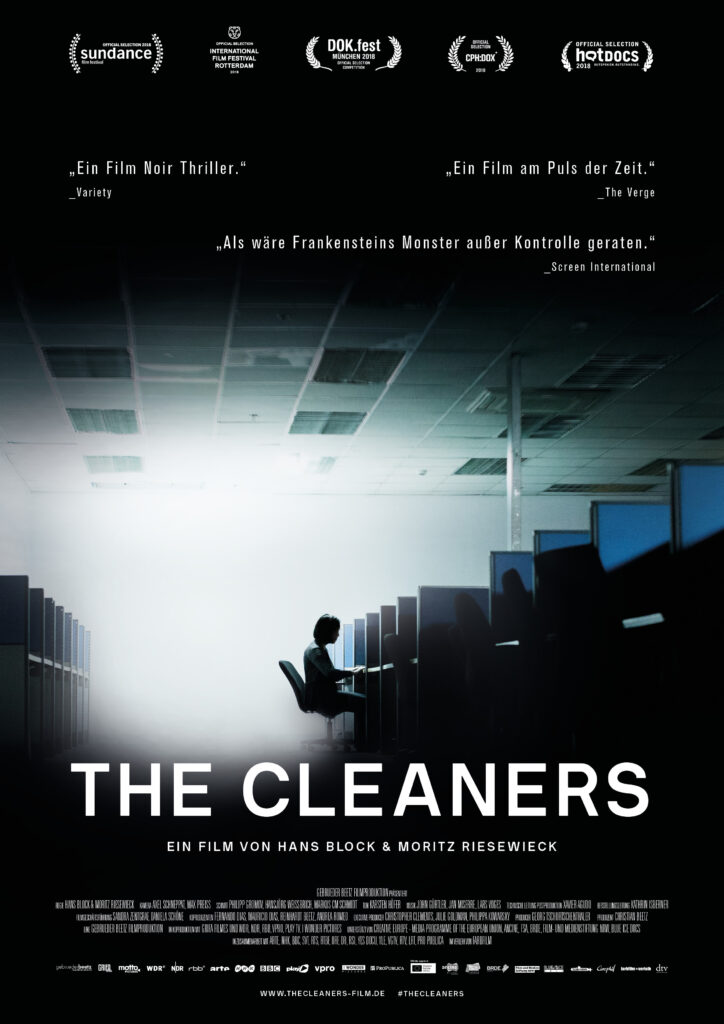
Until I heard about The Cleaners, I hadn’t given much thought to the possibility that people might actually be tasked with viewing images or films that facebook users flag as inappropriate. Given that the vast numbers of times this must happen in a day, I figured AI and algorithms were used to determine if images or videos would continue to be viewable (the fact that I’ve had content flagged and blocked, despite it very obviously not violating any terms or conditions, further strengthened this conclusion in my mind). And, okay, while AI may have a role, it also turns out that there are thousands of low-paid workers, mostly in the Philippines, who are required to view 25,000 blocked images and videos every day in order to decide if they will still be viewable. Understandably, this has a profound affect on the workers (who also, understandably, bring personal moral perspectives to bear on how they do their work—many of the workers appear to be Roman Catholic and supports of Duterte, then President of the Philippines, who explicitly called for a Nazi-style genocide against people take medications in criminalized ways). These workers are exposed to basically all the worst things you can think of when it comes to the internet. To provide one example, one worker was assigned to a special subdivision that spent eight hours a day monitoring livestreams focused on self-harm and suicide. He thrice requested a transfer out from that division and was thrice denied. After one last viewing of someone who hanged themselves on a livestream, he then hung himself in front of his computer.
I would have liked the directors to focus more attention on how fb treats these workers, what kind of pay and benefits they receive, how their efforts to create solidarity or collective action have been dismantled, what their overseers get paid in comparison to what they get paid, and so on. Instead, more focus is given to the ways in which facebook adjusts its filters and conditions in order to satisfy the regnant political powers in any given nation. Thus, it edits political content on videos in Turkey that are anti-Erdogan but doesn’t edit those videos when they are played in the United States. It filters how some hate-related videos in some countries, but allows all kinds of White supremacist videos to play in the United States. And so on. Thus, I found the focus of the documentary to be a bit fractured and felt that it didn’t do the best job of connecting how the abuse of workers fit in with Facebook’s broader political influence.
3. Brown, Margaret. The Order of Myths (2008).

There used to be a blog called “Stuff White People Like” and it was a pretty hilarious examination of various things that are unique to White culture (which is also great because White people like to deny they have a culture, as if “culture” is something unique and exotic assigned to BIPOC folx, whereas White culture is just, like, common sense or the norm or whatever—googling it now, I see it still exists: https://stuffwhitepeoplelike.com/!). Although “Having Black Friends” shows up on the list, I think the number one thing White people like is other White people. White supremacy, after all, has long been the glue that has held capitalism together in its heartlands (along with a good dose of patriarchalism and misogyny, as the working class was taught to identify more with White billionaires than with BIPOC folx who were impoverished, colonized, and often forcibly prevented from having membership within the working class). I was thinking about this again while watching Margaret Browns, The Order of Myths, which tells about how White and Black communities celebrate Mardi Gras in the still largely segregated city of Mobile/Africatown, Alabama. The ongoing presence of slavery in the structures of racialized capitalism are on full display here. There’s a lot of ways a director could approach this subject but Brown brings her gaze to bear in such a way that people reveal themselves—in fact, they reveal much more of themselves than they realize. It’s a great piece of work that I would love to discuss in a group. I’m looking forward to watching Descendant (2022), which received rave reviews and which, I think, is a follow-up to The Order of Myths.
4. Ophuls, Marcel. The Troubles We’ve Seen (1994).
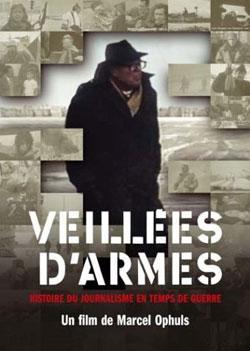
Marcel Ophuls is one of my favourite documentary filmmakers of all time. He’s a weaver, a wanderer, a witness, a mischief-maker, and a French-German Jew who survived WWII and whose profound insight into the good and evil that both so forcefully rise to the surface in human societies, is not to be missed. The Sorrow and the Pity (1969), Hotel Terminus (1988), and The Memory of Justice (1976), are all masterpieces. So, too, is The Troubles We’ve Seen, which focuses on war correspondents and journalism in relation to then occurring genocide in the former Yugoslavia. In many ways, this paves the way for future award-winning documentaries about the ethics and traumas of war journalism (like War Photographer [2003] or Restrepo [2010]). It also poses what turns out to be a prophetic warning about the dangers of embedding journalists with troops and how that fundamentally perverts journalism into propaganda, regardless of the intent of the journalist (something to bear in mind with the plethora of “reality” TV shows where the filmmakers are embedded with cops or security guards or border guards or other agents of state-based violence). Anyway, although the film runs for four hours (which is true of all of Ophuls’ films), it’s well-worth watching. His insights into the human heart and the human socius are perhaps even more relevant today than when his films were made.
5. Malkinson, Louise. MH370: The Plane That Disappeared (2023).
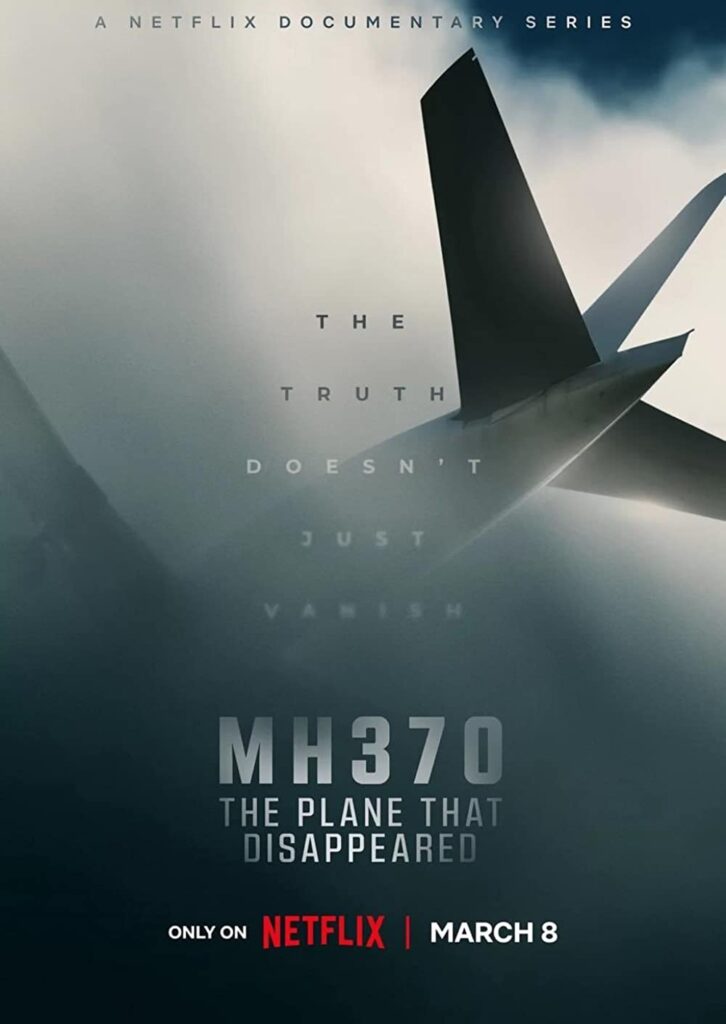
A three part docuseries, Malkinson presents three different theories on what happened to Malaysian Airlines flight MH370 when it “disappeared” on March 8, 2014. The first, which is basically the theory that has the most mainstream credibility, is that the pilot shut down all of the plane’s communication technology, took the plane off route, and crashed it in a suicidal act of mass murder in the south Pacific. This theory, despite having major reasons to question its veracity, is the one that the public has been taught to view as the common-sense and only “reasonable” solution to the disappearance. The second theory is absolutely outrageous and was pushed forward by an American who wanted to argue that Russians hijacked the plane and flew it into the desert in Kazakhstan in order to divert media attention from Russian acts of war in the Crimea. There is absolutely no evidence that this occurred and all kinds of evidence that it did not. The third theory, which actually is the most plausible based upon the actual evidence is that MH370 was shot down by the American military on its original route during the time (the American military was engaged in war game exercises at that place at that time). There are elements in this theory that seem to be a bit of a stretch as presented by Malkinson and the French investigative journalist who did the most work digging it up, but: (a) that the plane was not diverted; and (b) that the Americans then most likely bear responsibility for shooting it down, really seems like the most plausible scenario. Unless, of course, you are an American writing a review of this docuseries online. Then suggesting the Americans did it is treated like a mad conspiracy akin to saying it was aliens.
In many ways, it seems like theories one and two actually come from the same root—one designed to satisfy the general Western public who like to consider themselves reasonable people (even if there are strong elements of racism and sanism built into this theory in relation to the pilot), and one designed to keep throwing the scent off of the possibility that the plane did not divert from it’s route while also helping to create a narrative that would make other theories about a global power shooting down the plane appear equally tinfoil-hat-conspiracy-ish.
6. Askey, Colin. Love in the Time of Fentanyl (2023).
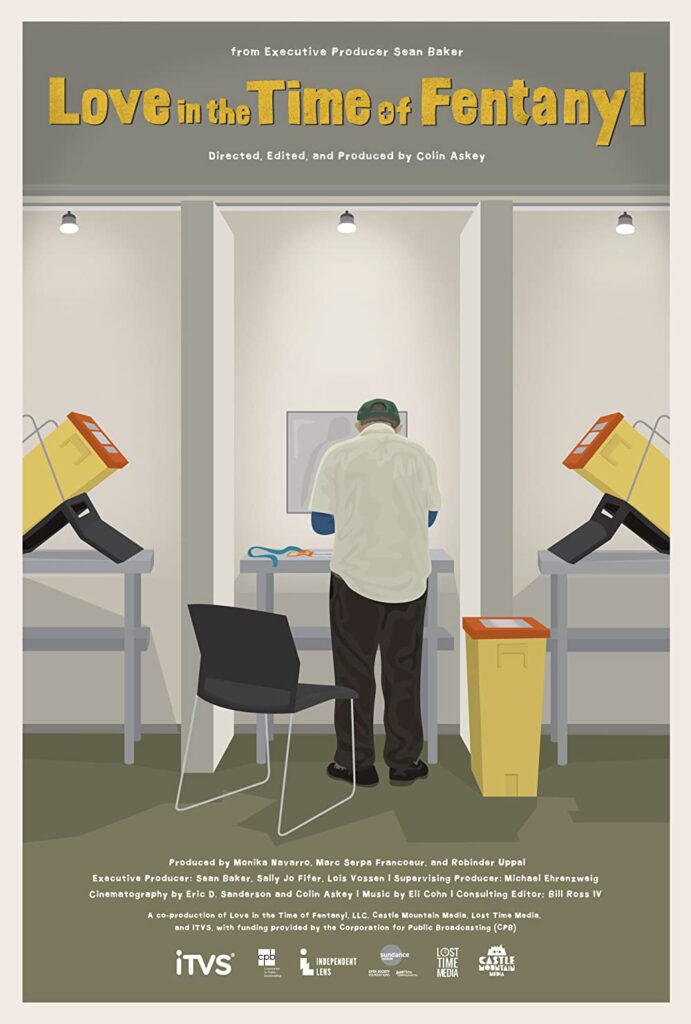
Love in a Time of Fentanyl does a very good job of inviting viewers into spaces that are rarely seen by the general public—the Overdose Prevention Site and its surroundings in the downtown eastside of so-called Vancouver—and presents those spaces, and the people who move through them, in a deeply human way. It neither demonizes nor romanticizes. It shows people being people, people grieving the deaths of so many loved ones, people fighting to save their own and other people’s lives, and people also playing together, creating art, engaging in tender acts of care, and also being silly, laughing, and dancing together. This is how people who oppressed not only survive but embody the uprising of life that wells up within them. Indeed, it was during the seven years I spent in that neighbourhood that I first concluded that wherever Death pushes down most forcefully, Life rises up most vigourously. I still believe that is true. Although talk of “Death” and “Life” is somewhat misleading because, really, what we are dealing with is economic and political forms of oppression. And this is my one criticism of the film: its brilliant and beautiful presentation of people as people never gets into the politics of gentrifuckation, land theft, colonization, and extractive abandonment that have created the so-called opioid crisis. What we are seeing is not so much an “opioid crisis” (although opioids are obviously involved), as it is a the mass manufacturing of death amongst forcibly impoverished and oppressed people whose healthcare has been criminalized. Apart from this quibble, this film is excellent. I recommend you watch it and you can watch it free online here: https://www.pbs.org/independentlens/documentaries/love-in-the-time-of-fentanyl/.
7. Abrams, Kevin. I Got a Monster (2023).
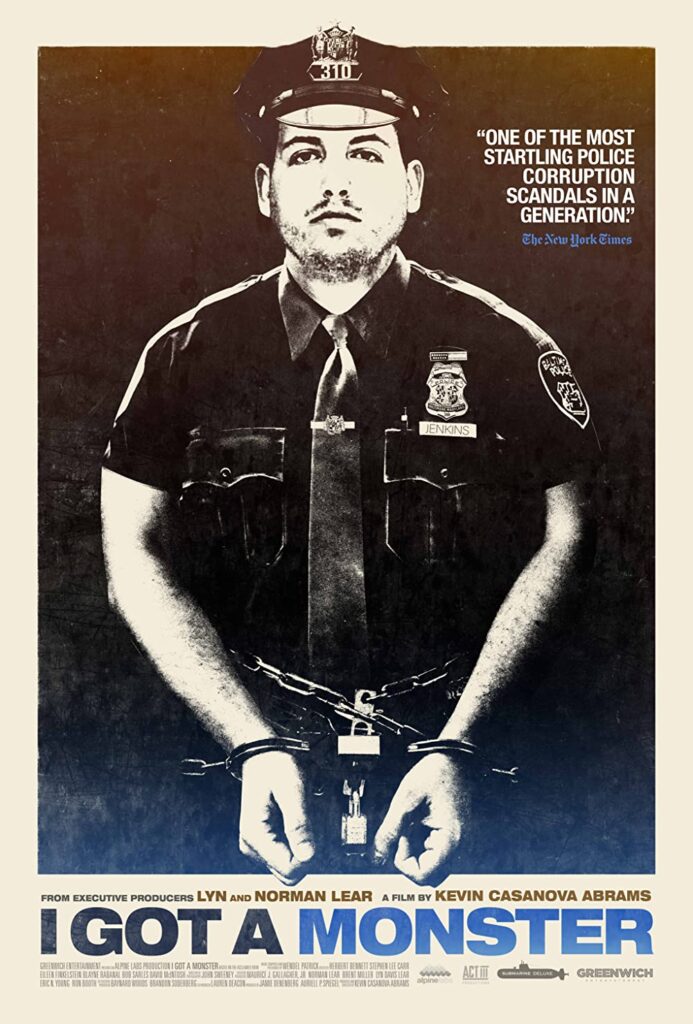
In this documentary we discover, for the 10,000,000,000th time, that cops are corrupt. And that they relentlessly destroy the lives of innocent people. In this case, it’s a special police task force in Baltimore that was doing the robbing and planting evidence and more robbing and more planting evidence and lying in court and falsifying documents and putting people in jail for years and destroying their ability to work and ruining their families and, yeah, same thing cops are doing everywhere. It’s a solid documentary (even if it exhibits too much faith in the ability of the system to change itself). I’ve watched a few in this genre and I think the one that has stayed with me the most is Craig Atkinson’s Do Not Resist (2016). It’s hard to forgot the cop training other cops to kill people by telling them that when they go home after killing someone and fuck their wives that they will have the very best orgasms of their lives.